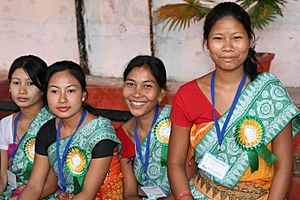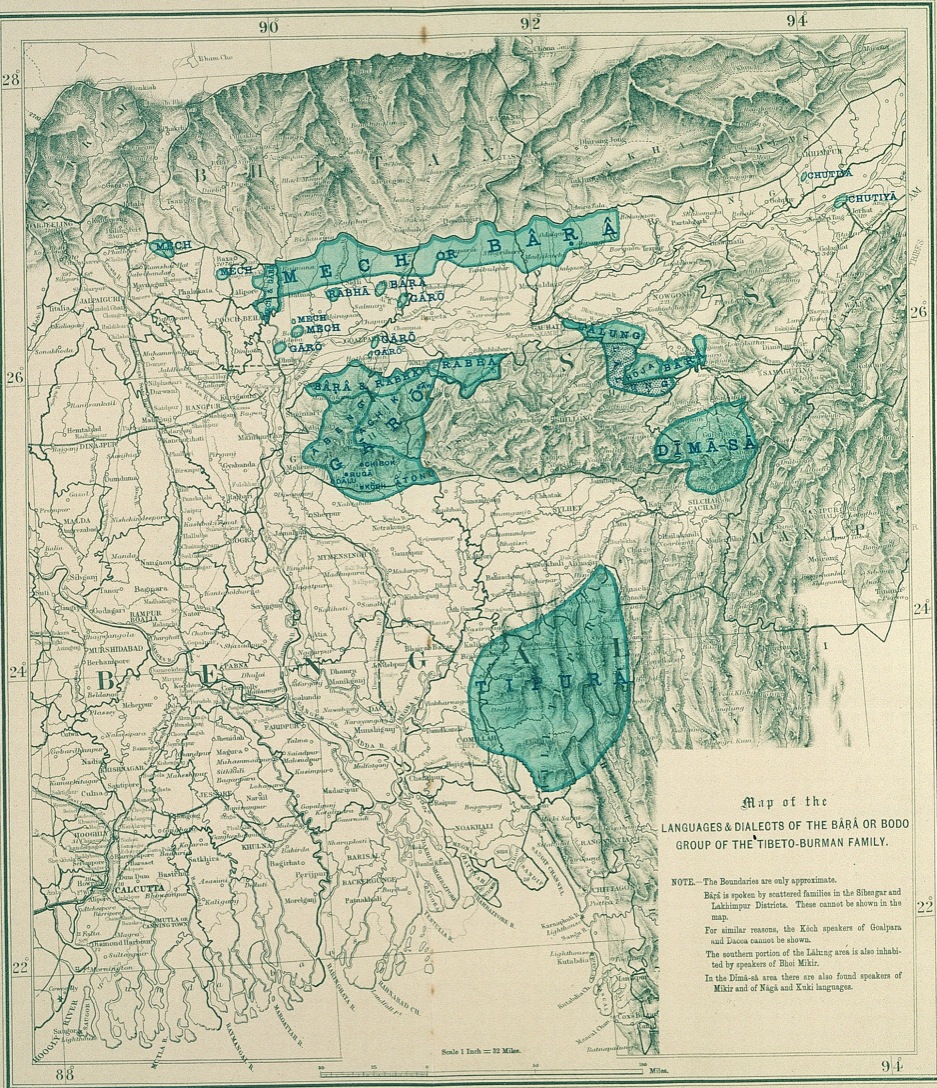Boro people facts for kids
| Boro | |
|---|---|

Boro bwisagu dance in traditional attire
|
|
| Total population | |
| 1.45 million (2011) | |
| Regions with significant populations | |
| Assam | 1.41 million (2011) |
| Languages | |
| Boro | |
| Religion | |
| Hinduism, Bathouism, Christianity | |
The Boro people, also known as Bodo, are the largest group of people in the state of Assam, India. They are part of a bigger family of groups called the Bodo-Kachari. You can find Boro people living across northeastern India, especially in the Bodoland Territorial Region of Assam. They also live in other parts of Assam and Meghalaya.
The Boro people speak the Boro language. It's part of the Tibeto-Burman language family. This language is one of the twenty-two official languages of India. Most Boro people also speak Assamese as a second language. The Boro people have lived in this region for a very long time, possibly for over 3,000 years. They are mostly farmers and have traditional ways of watering their fields.
The Boro people are recognized as a special group in the Indian Constitution. This means they have certain rights and powers in the Bodoland Territorial Region, which is a self-governing area.
Contents
What Does "Boro" Mean?
The word Boro is what the community calls themselves. It comes from Bara-fisa, which means "son of Bara." Bara means "man" or "male member" of the group. In a similar language called Kokborok, Borok means man. So, in the Boro language, Boro generally means "man" or, in a wider sense, "human being."
Boro Language
The Boro language is part of the Sino-Tibetan language family. It belongs to a group called Boro–Garo. It is an official language in the state of Assam and the Bodoland Territorial Region in India. It is also one of the twenty-two languages listed in the Eighth Schedule of the Constitution of India.
Boro Religion
Traditionally, Boro people follow a religion called Bathouism. In Bathouism, people worship a supreme God known as Obonglaoree. The shijou tree (a type of plant) is a special symbol of Bathouism and is worshipped.
In the Boro language, "Ba" means five and "thou" means deep. Boro people believe in five powerful elements of God: land, water, air, fire, and ether. This makes the number five very important in Bathou culture, similar to other Asian religions.
According to Bathouism, before the world was made, there was only a great empty space. In this space lived the supreme being 'Aham Guru', who had no shape. Aham Guru wanted to live in a physical form, so he came down and created the universe.
Many Boro people also follow Hinduism. They have special fire ceremonies called Hoom Jaygya. During these ceremonies, they offer things like betel nut, betel leaves, rice, milk, and sugar. Another important Hindu festival for Boros is the Kherai Puja, where an altar is set up in a rice field. Most Boro Hindus follow a set of rules called Brahma Dharma and do not practice caste or dowry.
About 10% of Boro people follow Christianity, mostly as Baptists. Major Boro Christian groups include the Boro Baptist Convention and Boro Baptist Church Association.
Boro History
For a long time, from the 12th century until the British came in the 1800s, different groups of people lived in various parts of Assam. The Boro people often moved to avoid being controlled by larger kingdoms like the Mughals, the Koch, and the Ahoms. They preferred to live near the forests in the lower Himalayan foothills.
In these areas, the Boros traditionally practiced shifting cultivation, which is a way of farming where they clear a piece of land, grow crops for a few years, and then move to a new area. They also used clever ways to water their fields. Farming, planting, harvesting, watering, and hunting were often done together as a community. The Boro people also traded forest products and other goods between the plains and the hills.
When the British took control in the late 1800s, they stopped people from using forest lands for farming. This caused problems for the Boro people because they lost the lands they had always used for their traditional farming and gathering.
Becoming the Boro People
The idea of a distinct "Boro identity" started to grow during the time of British rule. Educated Boro people began to see themselves as different from the Assamese Hindu society. In the early 1900s, a small group of Boro leaders emerged.
One important leader was Kalicharan Brahma. He started a new faith called "Brahma-ism" and helped create a strong Bodo identity. This new religion helped Boro people feel proud and independent, rather than having to fit into the Hindu caste system. By 1921, many Boros began to identify themselves as "Boro" by their group and language, and "Brahma" by religion. Some Boro people also became Christians, which offered another way to express their identity.
Early Boro leaders like Kalicharan Brahma and Jadav Khakhlari worked to protect the rights of their community. They asked the British government for special protection and representation for the Boro people.
Boro Population
About 1.45 million Boro people live in Assam, which is about 4.53% of the state's total population. Most of them, around 68.96%, live in the Bodoland Territorial Region of Assam. In this region, about 1 million Boro people live out of a total population of 3.15 million, making them about 31% of the region's population.
Boro Stories and Clans
The history of the Boro people can also be understood through their folk stories. According to a famous scholar, Suniti Kumar Chatterjee, Boro people are believed to be the "offspring of the son of the Vishnu (Baraha) and Mother-Earth (Basumati)" in ancient stories.
The Boro people have different family groups or clans. The word Aroi or Ari or Ary in the Boro language means "folk" or "people."
Here are some important Boro clans:
- Swargiary: This is the priestly clan.
- Basumatary: This clan is known for owning land.
- Narzary: This clan is linked to growing and supplying jute.
- Mosahary: This clan is associated with protecting cattle.
- Goyary: This clan is linked to growing areca nuts.
- Owary: This clan is associated with supplying bamboos.
- Khakhlary: This clan is linked to a plant needed for the kherai puja festival.
- Daimary: This clan is associated with rivers.
- Lahari: This clan collects large amounts of leaves for festivals.
- Hajoary: This refers to Boros who lived in the hills and foothills.
- Kherkatari: This clan is associated with thatch (roofing material) and its supply.
- Sibingari: This clan traditionally raised and supplied sesame.
- Bingiari: This clan is associated with musical instruments.
- Ramchiary: This name comes from a place called Ramsa.
- Mahilary: This clan is associated with collecting taxes from certain areas.
Notable Boro People
- Rajni Basumatary – A filmmaker and actress.
- Ankushita Boro – An Indian boxer.
- Jamuna Boro – Another Indian boxer.
- Pramod Boro – A political leader and the current Chief Executive Member of the Bodoland Territorial Council.
- Harishankar Brahma – The 19th Chief Election Commissioner of India.
- Upendra Nath Brahma – A Boro activist, known as Bodofa (father of the Boros).
- Sansuma Khunggur Bwiswmuthiary – A former Member of parliament.
- Hagrama Mohilary – A political leader and former Chief Executive Member of the Bodoland Territorial Council.
- Ranjit Shekhar Mooshahary – A former governor of Meghalaya and a retired police officer.
- Halicharan Narzary – An Indian footballer.
- Proneeta Swargiary – The winner of Dance India Dance (season 5).
Images for kids
See also
 In Spanish: Bodo para niños
In Spanish: Bodo para niños
- Bodo Sahitya Sabha
- Bodo culture
- Ual (tool)






